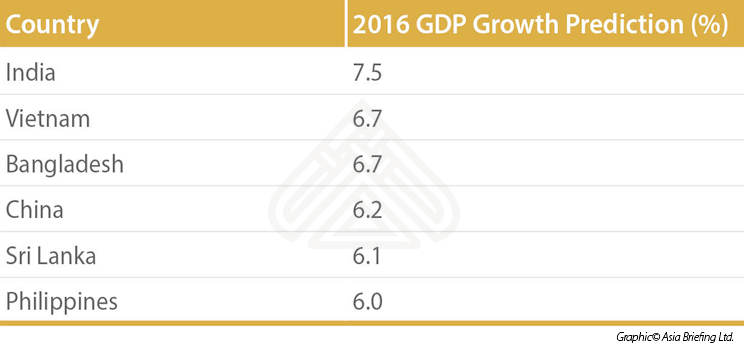Vietnam is set to be one of the performing global stars in terms of growth during 2016, according to an essay from Bloomberg titled “Vietnam Growth Makes It An Emerging Market Standout In a Shaky World”. Citing generally difficult trading conditions in 2016, Bloomberg’s market analysis places Vietnam as the second most dynamic growth economy during the year with an expected 7 percent growth rate. India in fact leads the way with an expected GDP growth performance of 7.5 percent – some way ahead of China’s 6.2 percent prediction.
Bloomberg have categorized the fastest growing Asian economies this year as follows:

Bloomberg state “Rising domestic demand and booming foreign direct investment are helping (Vietnam) counter global threats that’s sparked a wave of stock selling and currency depreciation this year.”
If correct, the figures will see Vietnam’s overall GDP growth performance tick upwards to near the 7.5 percent GDP growth it last experienced in 2005, prior to the Global downturn.
Bloomberg’s assessment matches pretty much with what we’ve seen on the ground, although their report doesn’t mention the potential impact of the TPP. Our offices in both Hanoi and HCMC have seen growth in foreign investing clients into Vietnam, with many American corporations in particular starting to take the plunge and invest in the country. There are also numerous cases of foreign investors with existing facilities in China, and Guangdong Province in particular, moving capacity to Vietnam where operational overheads are cheaper. The China facilities aren’t closing – yet – but some may should the TPP come to fruition.
Vietnam’s position within the TPP agreement will essentially see it act as a contract manufacturer and supplier, duty free, of products destined directly for the U.S. market, but crucially at low or zero import tariffs to the U.S., something China cannot match. This means that some China production will, under the ASEAN-China Free Trade Agreement, be exported duty free to Vietnam, finished, and then re-exported to the United States under the TPP deal. Vietnam will become an outsourcing platform, and if that occurs, Bloomberg’s growth analysis for the country’s performance may well need to be revised upwards. The potential trade structure look like this:

This is especially pertinent in the textiles industry, where the TPP “Yarn Forward” program is set to benefit Vietnam especially. I outlined the benefits for Vietnam and the implications for China in the article “The US TPP Yarn Forward Program and Implications for China & Vietnam”. In terms of other participating TPP nations, I summarized the processing trade prospects and opportunities under the TPP for Australia, New Zealand, Malaysia & Vietnam here.
The good news for concerned foreign invested China based manufacturers is that Vietnam offers a potential way out of a declining Chinese economy in the near short term. China’s economic rebalancing won’t last forever, yet the TPP agreement allows a quick fix alternative to what are currently diminishing China returns amongst higher operational costs and slowing consumer demand. This is one of the primary reasons why the Vietnamese market looks a good manufacturing and processing investment bet. Culturally, and in terms of business administration, Vietnam is similar to China – those executives who have gone through the procedures of setting up a factory or trading company in China will find the Vietnamese legal system familiar. Of note to foreign investors in Vietnam, however, is the fact that is it a play largely dependent upon trade agreements. The benefits I have described are enshrined within the TPP deal, as well as within Vietnam’s adherence to the ASEAN-China Free Trade Agreement. Professional knowledge is required of these to gain the maximum understanding of why Vietnam is a good call for 2016 and beyond, and how to maximize corporate performance based on the same tax and tariff reductions. This article, of special pertinence to China based investors, is a good place to start: “China’s Agreement With ASEAN and What It Means For China-Based Foreign Manufacturers”.
Meanwhile, the China hawks may crow at the slowing economy, yet even as China loses some manufacturing capacity to Vietnam, it also spurs the Chinese manufacturing industry to become more innovative. It will take a while for the penny to drop for some of the traditional Chinese manufacturers, but they will learn fast as business starts to slip away to Vietnam. That may mean a medium term slowdown as the economy rebalances and starts to look at adding value and innovating. In the meanwhile, Vietnam offers a backdoor route from China into the lucrative markets of the United States and beyond. Taking advantage of this should be on the agenda for all China based foreign manufacturers.
|
To obtain a complimentary subscription to Asia Briefing and Chris’s updates, please click here. |
![]()
 The Trans-Pacific Partnership and its Impact on Asian Markets
The Trans-Pacific Partnership and its Impact on Asian Markets
In this issue of Asia Briefing magazine, we examine where the TPP agreement stands right now, look at the potential impact of the participating nations, as well as examine how it will affect Asian economies that have not been included.
 Import & Export in Vietnam: Key Industries & Free Trade Agreements
Import & Export in Vietnam: Key Industries & Free Trade Agreements
In this issue of Vietnam Briefing magazine, we discuss the key aspects of Vietnam’s import and export landscape, focusing on textiles, telephones and computer products, and automotive parts. We then analyze opportunities for Vietnam among its inclusion in multilateral regional trade blocs, before examining the European Union-Vietnam Free Trade Agreement in detail. Finally, we give an overview of the requirements for establishing a trading company in Vietnam.
 Navigating the Vietnam Supply Chain
Navigating the Vietnam Supply Chain
In this edition of Vietnam Briefing, we discuss the advantages of the Vietnamese market over its regional competition and highlight where and how to implement successful investment projects. We examine tariff reduction schedules within the ACFTA and TPP, highlight considerations with regard to rules of origin, and outline the benefits of investing in Vietnam’s growing economic zones. Finally, we provide expert insight into the issues surrounding the creation of 100 percent Foreign Owned Enterprise in Vietnam.



